Kontrol 1.27 mm Pitch Connectors
Kontrol connectors can withstand 20G vibration and operate across a wide temperature range
Kontrol connectors can withstand 20G vibration and operate across a wide temperature range
G9EJH-1-E compact relays are designed for 800 VDC pre-charging applications
Enclosures with mounting flanges ideal for housing electronic devices in industrial environments
Recently, DigiKey officially launched its Indian subsidiary, named Digi-Key Electronics & Automation Trading Private Limited, incorporating its existing Global Capability Center (GCC) in Bengaluru. “We always considered this location to be a very strategic hub for DigiKey,” stressed the company’s CIO, Ramesh Babu, in an exclusive interview with CircuitDigest.
This DIY Bluetooth Speaker is a budget-friendly project that delivers clear wireless audio using affordable components. With the help of a DIY Bluetooth Speaker amplifier, the Bluetooth module sends the audio signal to the amplifier, which then provides the necessary power to drive the speakers. It can also be used for building a DIY Bluetooth portable speaker. The setup is simple, compact, and powerful for anyone looking to create their own portable speaker without spending a lot. It’s a fun and practical way to learn the basics of electronics.
If you’re interested in this type of project, there are also a few improved versions you can explore. One of them is Simple DIY Wireless Bluetooth Speakers Using an Audio Amplifier, which includes an upgraded amplifier and speaker setup to deliver noticeably better sound performance. Another is the Arduino Bluetooth Speaker with Reactive NeoPixel LEDs, an advanced version that integrates dynamic lighting effects using NeoPixel LEDs for a more interactive experience. These projects are built on the same core concept while adding new features to your DIY Bluetooth Speaker.
Building a DIY Bluetooth Speaker requires only a handful of essential DIY Bluetooth Speaker components. Below is a comprehensive list of everything you'll need for this project:
| Components | Description |
| JDY-62 Bluetooth Module | Bluetooth 4.2 audio module used to receive wireless audio signals. |
| PAM8403 Amplifier | A 5V stereo amplifier that boosts the audio output for the speakers |
| 2-Watt 8Ω Speakers | Compact speakers used to output the left and right audio channels. |
| Wires | Used for electrical connections between modules. |
| Soldering Iron | Required to solder wire and ensure stable, long-lasting connections. |
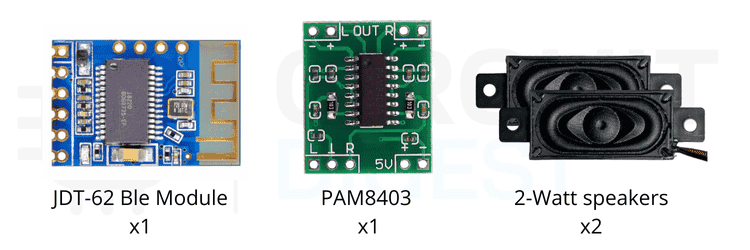
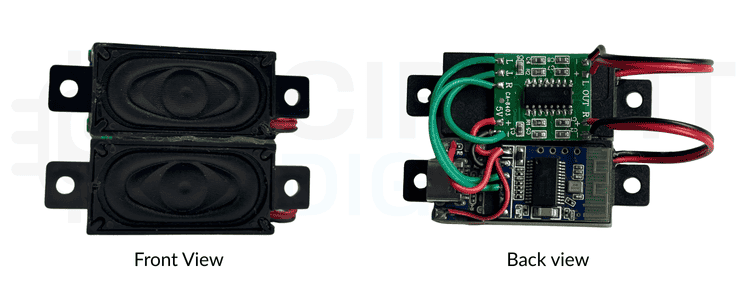
In order to successfully assemble a working DIY Bluetooth Speaker, it is important to have a sound understanding of the pinouts and connections of each component. Connecting a component in a circuit with the wrong polarity can sometimes damage the component or make the circuit unusable. Let’s examine each component in detail:
JDY-62 Bluetooth 4.2 Audio Module
The JDY-62 enables wireless audio streaming from your phone or device. It can be used for building DIY Bluetooth stereo speakers, handling the Bluetooth connection and sending the audio signal to the amplifier for wireless playback. It's ideal for building DIY Bluetooth stereo speakers, handling the Bluetooth connection and transmitting high-quality audio signals to the amplifier for wireless playback.

| Pin Name | Function | Description |
| VCC | Power Supply | Connect to +5V DC |
| GND | Ground | Connect to ground. |
| L OUT | Left Audio Output | Sends the left channel audio signal to the amplifier. |
| R OUT | Right Audio Output | Sends the right channel audio signal to the amplifier. |
The PAM8403 is a small, efficient audio amplifier that powers the speakers to produce clear sound. It can be used for creating a DIY Bluetooth Speaker amplifier, boosting the audio signal from the Bluetooth module so the speakers deliver crisp, high-quality sound. With its Class-D architecture, the PAM8403 operates efficiently with minimal heat generation, making it ideal for building a DIY Bluetooth portable speaker powered by batteries or USB power banks.
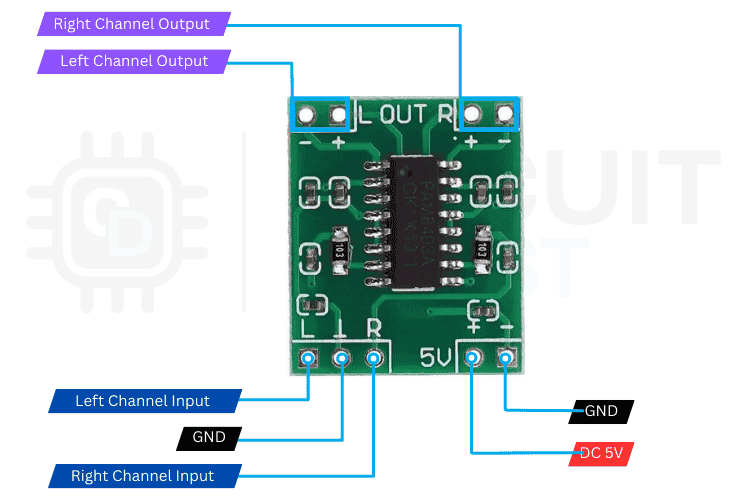
| Pin Name | Function | Description |
| VCC | Power Supply | Connect to +5V DC |
| GND | Ground | Connect to ground. |
| L IN | Left Audio Input | Connect to the left output from the Bluetooth module. |
| R IN | Right Audio Input | Connect to the right output from the Bluetooth module. |
| L OUT | Left Speaker Output | Connect to the left speaker terminals |
| R OUT | Right Speaker Output | Connect to the right speaker terminals. |
You can also build your own amplifier circuit. If you need some guidance, you can refer to projects like the Simple Arduino Audio Player and Amplifier with LM386 or the Simple Microphone to Speaker Amplifier Circuit. These alternatives offer different power levels and features for customising your DIY Bluetooth stereo setup.
The DIY Bluetooth Speaker wiring diagram shows the connection between the JDY-62 Bluetooth 4.2 module, the PAM8403 audio amplifier, and the two 2W/8Ω speakers. Using the right DIY Bluetooth Speaker components, the Bluetooth module and amplifier share the same 5V power supply, while the left and right audio signals are routed directly from the JDY-62 to the corresponding inputs on the PAM8403. Each speaker is connected to the amplifier’s left and right outputs of the amplifier, enabling the stereo audio setup
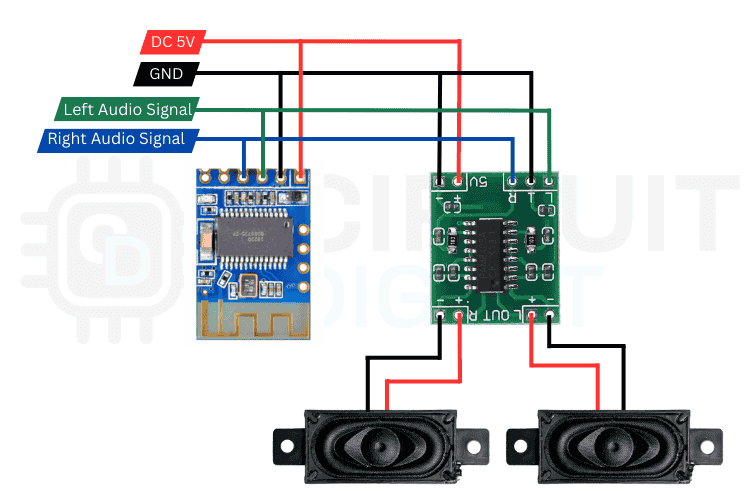
Wiring Instructions
Once you've completed the wiring according to the DIY Bluetooth Speaker wiring diagram, powering on your device triggers automatic functionality. When powered on, the device instantly reconnects via Bluetooth if it has been paired with that device before. For a new device, you need to pair it manually. Just look for “JDY-62” in the available Bluetooth devices list. The indicator light confirms the connection status, while the speakers deliver clear, high-quality audio that’s ready to play immediately. This easy connection and good sound quality make it a reliable choice for anyone looking to enjoy wireless audio without any hassle. Many builders ask, "How to make a Bluetooth speaker louder DIY" after completing their initial build.
Building a DIY Bluetooth Speaker on a budget is an easy and fun way to enjoy wireless music while learning basic electronics. With simple components, you can create a portable, clear-sounding speaker without spending much, making it a perfect project for beginners and hobbyists.
1. Upgrade to a More Powerful Amplifier: The PAM8403 is a good product for basic uses, but upgrading to a PAM8610 (10W per channel at 12V) or TDA7297 (15W per channel) will dramatically increase maximum volume. Because the power supply will need to deliver higher current, ensure that your power supply can comply with this. Higher wattage amplifiers require somewhat like 2-3A of power delivery. This is the single best upgrade for anyone asking how to make a Bluetooth speaker louder DIY.
2. Source a Higher Wattage Speaker: If you replace the 2W speaker with either a 5W or 10W speaker, the amplifier will be able to deliver more acoustic power without distortion. Be sure to match the impedance (4Ω or 8Ω) of your speaker to your amp. Using larger speaker drivers (40mm-100mm diameter) will also provide better bass response and sound projection overall.
3. Make sure to use a proper power supply: Many of the volume problems are simply due to not getting adequate current. Use a supply rated at least 2A for PAM8403 and 3A or greater for any more powerful amp. For any DIY Bluetooth portable speaker, you can consider a supply like hi-capacity power banks (10,000mAh+) or several 18650 Li-ion cells in series-parallel with charging circuit options.
4. Construct an Effective Enclosure for Speakers: An acoustic enclosure eliminates the issue of sound waves existing in the same space and from cancelling each other out. Enclosures also help to create stronger bass frequencies. An easy solution would be to create just a simple sealed box, which can increase perceived volume and sound quality quite a bit. Whatever the construction, make sure to measure the volume of the enclosure you want to create around your speaker specs. Most small drivers need 0.5-2 litres of enclosure volume, or whatever the manufacturer recommends. For the best results, use a dense material like MDF, plywood, or even solid hardwood.
5. Improve Connections of Components: Use thicker wiring (a reasonable range is 18-20 AWG) on speaker connections, as it acts as resistance to the speaker. Keep all wire runs short and clean, as clean solder joints are also valuable, as bad solder connections create signal loss and distortion. If your amplifier's integrated chip runs hot during long periods of use, add heat sinks.
⇥ 1. How does Bluetooth pairing work?
Once powered on, the JDY-62 module automatically enters pairing mode. It can connect to your smartphone, laptop, or any Bluetooth-enabled device. No additional configuration is required.
⇥ 2. Does it require any app or software to work?
No app is needed. It works as a standard Bluetooth audio device, so any device that supports Bluetooth audio can connect to it.
⇥ 3. Can I use different speakers?
Yes, but make sure the speaker matches the amplifier’s output. Using a higher power speaker without adjusting the circuit may damage the amplifier.
⇥ 4. How can I make my DIY Bluetooth speaker louder?
Use a more powerful amplifier, a larger speaker, provide stable power, and use short, thick wires to reduce signal loss.
In this post, we will build a Raspberry Pi-based Bluetooth Speaker by combining the power of A2DP, Linux, and an audio codec to stream data packets from an audio source to an audio sink wirelessly.
Creating a DIY Bluetooth Speaker is a fun and easy way to experience music wirelessly while learning basic electronic concepts. You can buy the components to make a basic DIY Bluetooth Speaker components less than $6 and build a portable speaker that sounds just as clear as expensive commercial speakers. Whether you make a basic desktop speaker or a more advanced DIY Bluetooth portable speaker that is battery-powered, the principles are the same. Your DIY Bluetooth stereo journey starts here—have fun building and enjoy your wireless music!
This tutorial was created by the CircuitDigest engineering team. Our experts focus on creating practical, hands-on tutorials that help makers and engineers master Raspberry Pi projects, Arduino projects, Electronic circuits and IoT development projects.
Previously, we have used different types of speakers to build many interesting projects. If you want to know more about those projects, the links are given below.
How to Build an Amazon Alexa Speaker using Raspberry Pi
In this tutorial, I will show you how to build your own DIY version of the Amazon Alexa by installing Alexa Voice Service (AVS) on a Raspberry Pi 4.
Here we use LM386 and a speaker with ESP32 to play music files. The audio output may not be loud, but this application shows the ability of the ESP32 board to play audio files.
ESP32 Based Internet Radio using MAX98357A I2S Amplifier Board
To build our ESP32 web radio, we have chosen the ESP32 development board (obviously) and the MAX98357A I2S Amplifier board.
Raspberry Pi Bluetooth Speaker: Play Audio wirelessly using Raspberry Pi
In this post, we will build a Raspberry Pi-based Bluetooth Speaker by fusing the power of A2DP, Linux and an audio codec to stream the data packets from an audio source to an audio sink wirelessly.
Over the years, I’ve collected a few Raspberry Pi boards, my trusty Pi 4 and even an older Pi 3 that was gathering dust in a drawer. Instead of letting them sit unused, I decided to give them a new life by turning them into something surprisingly practical: a Raspberry Pi WiFi router with built-in ad-blocking capabilities.
With the help of RaspAP’s pre-built image, I managed to transform these little boards into wireless routers that not only share the internet but also strip out ads at the network level. That means every device I connect, laptops, phones, even smart TVs, enjoys cleaner, faster browsing. And because a Raspberry Pi can run off a simple power bank, it doubles as a portable travel router, perfect for hotel stays or road trips.
Now, if you prefer the hardcore way with OpenWrt, we’ve already covered how to run it on Raspberry Pi in another guide Turn your Raspberry Pi into a WiFi Router using OpenWrt. And if you’re someone who wants to dive deeper into the world of Raspberry Pi, you’ll find plenty more hands-on Raspberry Pi projects here on CircuitDigest. This guide is just one of many experiments we’ve done, and you can always find new ways to unlock more potential from your Pi.
OpenWrt is a beast; it’s robust, battle-tested, and used in enterprise-grade routers. But when it comes to Raspberry Pi as router applications, it often feels like putting racing tyres on a bicycle. You can make it work, but you’ll spend hours tweaking.

RaspAP, on the other hand, feels like it was designed for the Pi. It has a clean, modern web interface, preconfigured settings, and beginner-friendly defaults. In short, OpenWrt is for networking experts, RaspAP is for Raspberry Pi enthusiasts who want results fast. The RaspAP setup process is straightforward, and you can have a functional Raspberry Pi WiFi hotspot with Ethernet connectivity running in under 30 minutes. For additional insights on network configuration, refer to this comprehensive tutorial on configuring a Raspberry Pi to share Wi-Fi through its Ethernet port.
Before we begin the RaspAP setup, let's gather everything you'll need to successfully turn Raspberry Pi into WiFi router:
One thing that often confuses beginners when learning how to connect Raspberry Pi to WiFi router setup is the different network interfaces on the Raspberry Pi. Here’s how RaspAP organises for your Raspberry Pi WiFi router project:
In my setup, I kept things simple: eth0 as the internet input, wlan0 as the output hotspot. But knowing you can add a second dongle or even tether your phone makes the Pi router far more versatile than I expected. This flexibility allows you to use your Pi as a RaspAP WiFi repeater or even a standalone portable router powered by mobile data.
Google recently made life harder for traditional ad blockers like uBlock Origin by crippling their features in Chrome, which means YouTube ads sneak through again. But RaspAP blocks ads at the DNS level, meaning the requests for ad servers are killed before they ever reach your browser. This DNS-based approach works across all devices connected to your Raspberry Pi WiFi router, smartphones, tablets, smart TVs, and gaming consoles, without requiring individual ad blocker installations.
⇒ Step 1: Flashing the RaspAP Pre-Built Image
I started by downloading the RaspAP pre-built image from their official GitHub page. It’s based on Raspberry Pi OS Lite but already configured with RaspAP installed.

Using Raspberry Pi Imager, I selected “Use custom image,” pointed it to the file, and flashed it to a 16GB microSD card. The process took a few minutes, and then I slotted the card into my Pi 4 and powered it up.

Within a couple of minutes, a new network appeared in my PC’s Wi-Fi scan list called RaspAP. This automatic network creation is one of the major advantages of using the pre-built image; no command line configuration is needed to get started with your Raspberry Pi wireless router.
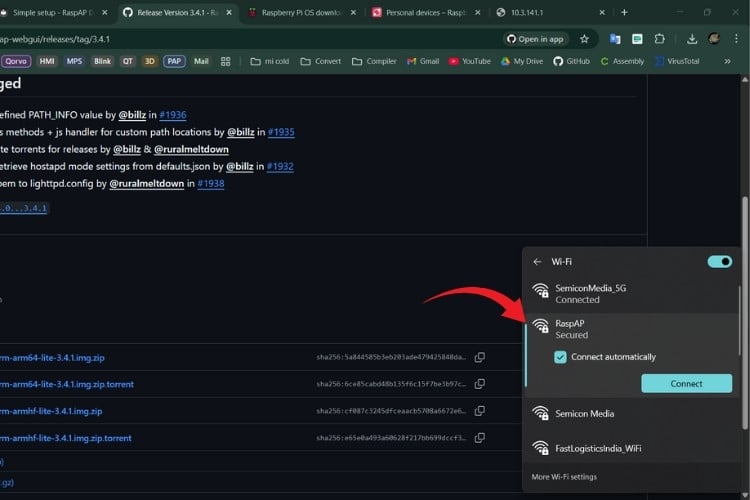
I connected to it using the default password ChangeMe, and just like that, I was connected to my brand-new Pi-powered Wi-Fi hotspot. No complex networking commands or terminal configurations required, this is what makes RaspAP ideal for those learning how to connect Raspberry Pi to WiFi router configuration.
⇒ Step 2: Accessing the RaspAP Dashboard
Once connected to the RaspAP network, I opened my browser and typed:
| http://10.3.141.1 |
This brought up the RaspAP web interface. The default login was:
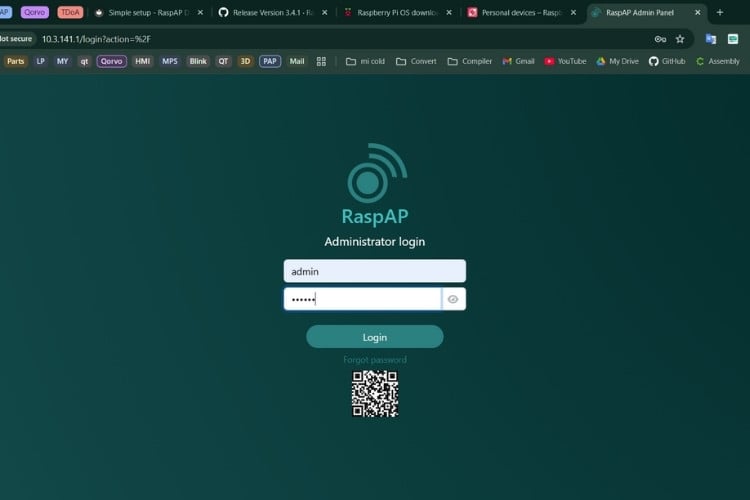
After logging in to complete the RaspAP setup, I was greeted by a sleek dashboard showing connected clients, bandwidth graphs, and hotspot controls. It honestly felt like I was using the interface of a commercial router, not a $35 single-board computer turned into a Raspberry Pi WiFi router.

⇒ Step 3: Customising Your Raspberry Pi WiFi Hotspot Settings
By default, the hotspot is named RaspAP with the password ChangeMe. That’s fine for testing, but not something you’d want to leave running; anyone who knows the defaults could connect to it.
From the Hotspot settings page in the RaspAP dashboard, I made a few important changes for my Raspberry Pi wireless router:

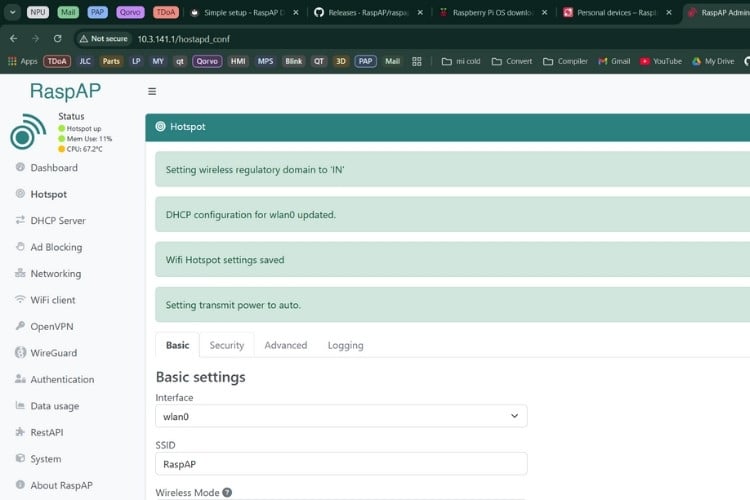
After saving the changes, RaspAP prompted me to reboot the hotspot. When the Pi came back online, my customised Wi-Fi network appeared in the scan list with the new name and settings. I reconnected with the new password, and everything worked smoothly. This completes the basic RaspAP setup for your Raspberry Pi WiFi router.

⇒ Step 4: Setting Up DNS-Based Ad Blocking
One of the best features of RaspAP for your Raspberry Pi WiFi router project is its built-in DNS-based ad blocker. Unlike browser extensions, which only block ads on a single device, this works at the network level, meaning every device that connects to your Raspberry Pi wireless router gets ad-free browsing.
Enabling Network-Wide Ad Blocking
To activate ad blocking on your Raspberry Pi WiFi router, follow these steps:

After the reboot (which takes approximately 30-45 seconds), your Raspberry Pi WiFi router will act as both a router and a network-wide ad filter, blocking advertisements, tracking scripts, and malicious domains before they reach any connected device.
To confirm that the ad blocking is working properly on your Raspberry Pi wireless router, I performed several tests:


After completing the RaspAP setup, I wanted to benchmark how fast my Raspberry Pi WiFi router really performed compared to commercial routers. Here’s what I measured:



Not blazing fast compared to high-end WiFi 6 routers, but impressive considering this Raspberry Pi wireless router was running on a board the size of a credit card, with built-in ad blocking, and costing a fraction of commercial alternatives.
The more I explored the RaspAP dashboard, the more I realised my Raspberry Pi WiFi router wasn’t just a simple hotspot manager; it had a full set of features you’d normally expect from a commercial router. Here are some of the highlights I tested:
→ VPN Support for Secure Connections: RaspAP integrates with both OpenVPN and WireGuard, letting you route all network traffic through a VPN server. This is useful if you want to secure devices that don’t natively support VPNs, like smart TVs or IoT gadgets. For travel, this feature is especially handy; you can connect your Pi to hotel Wi-Fi and automatically tunnel all your traffic through your home VPN, like smart TVs, gaming consoles, or IoT gadgets, by connecting them to your Raspberry Pi WiFi router.

For travel scenarios, this feature is especially handy: you can connect your Raspberry Pi WiFi hotspot with Ethernet to hotel Wi-Fi and automatically tunnel all your traffic through your home VPN, creating a secure network wherever you go. This transforms your Pi into a true portable RaspAP WiFi repeater with VPN capabilities
→ Bandwidth Monitoring and Traffic Analysis: The dashboard includes real-time traffic graphs and per-device usage statistics. I could instantly see which devices were using the most bandwidth on my Raspberry Pi wireless router, which is useful if your network feels slow and you suspect one device is hogging the connection.
→ Firewall & Port Forwarding Configuration: RaspAP gives you a web interface for firewall rules, making it possible to block certain devices, restrict traffic types, or expose a local service to the outside world. For example, you could configure port forwarding on your Raspberry Pi WiFi router to make your Pi's web server or home automation system accessible remotely while maintaining security.
→ Bridged vs Routed Network Modes: By default, the Pi works in routed mode, acting as a proper NAT router. But switching to bridged mode allows your Raspberry Pi WiFi router to extend an existing network without creating a new subnet. This flexibility means you can choose between a fully independent Pi-based router or a transparent RaspAP WiFi repeater, depending on your specific networking needs.
What impressed me most was how scalable this Raspberry Pi WiFi router project feels. For a small home lab, a travel router, or even a secondary network at home, RaspAP offers enough features to experiment with advanced networking while still being beginner-friendly.
While RaspAP provides an excellent web interface, you may occasionally need to connect Raspberry Pi to WiFi command line for troubleshooting or advanced configuration. These commands are particularly useful when setting up your Raspberry Pi wireless router in headless mode (without monitor/keyboard) or when troubleshooting connectivity issues remotely via SSH.
⇥ 1. Can I use Raspberry Pi 3 or Raspberry Pi 5 with RaspAP?
Yes. RaspAP works across Pi 3, 4, and 5. The Pi 3 is slower and best for light use, while the Pi 5 delivers speeds close to budget consumer routers.
⇥ 2. What are the default login details for RaspAP?
⇥ 3. Why don’t I see the Wi-Fi hotspot (raspi-webgui) after the first boot?
Make sure your Pi’s built-in Wi-Fi is not blocked. On some models, you may need to run:
| sudo rfkill unblock wifi |
Then reboot. If you’re using a Pi 3, check that the microSD image flashed properly.
⇥ 4. My Pi connects, but I don’t get internet on devices. What’s wrong?
Check the uplink interface (the source of the internet):
⇥ 5. How many devices can RaspAP handle at once?
It depends on your Pi model and internet source:
⇥ 6. Does RaspAP really block YouTube ads?
Yes, but not in the same way as browser extensions. Since ad-blocking happens at the DNS level, it prevents connections to known ad servers. This works on TVs, phones, and tablets too. It won’t block every single YouTube ad (since some are served from the same domains as content), but it cuts out most ads better than today’s crippled browser-based blockers.
⇥ 7. Can I replace my main home router with RaspAP?
Technically, yes, but keep expectations realistic. A Pi 4 or Pi 5 can handle small households, but for gigabit internet and 20+ devices, you’ll want a dedicated router. RaspAP is best as a travel router, learning project, or secondary network.
⇥ 8. I forgot the web dashboard password. How do I reset it?
SSH into your Pi and run:
| sudo htpasswd /etc/raspap/raspap.auth admin |
Then set a new password for the admin user.
⇥ 9. My Wi-Fi speed is slow compared to my main router. Why?
Remember, the Raspberry Pi’s Wi-Fi hardware is mid-range. For better speeds:
Use a Pi 5 with an external USB Wi-Fi dongle.
Stick to 5 GHz instead of 2.4 GHz if your devices support it.
Keep your Pi in an open space to avoid interference.
⇥ 10. Why not just use OpenWrt instead of RaspAP?
You can, but OpenWrt on Pi requires more manual tweaking and isn’t as beginner-friendly. RaspAP is built specifically for Raspberry Pi, with plug-and-play defaults, a modern dashboard, and extras like built-in ad-blocking.
By the end of this project, my Raspberry Pi wifi router project had gone from sitting idle on my desk to running as a mini router with DNS-based ad blocking, and even VPN support. All of this came together with very little effort thanks to the RaspAP pre-built image, which saved me from complicated manual configurations.
OpenWrt indeed remains the heavyweight option for dedicated routers, especially for advanced networking scenarios. But when it comes to Raspberry Pi as router applications, RaspAP delivers the perfect middle ground, powerful enough to give you features like WireGuard, bandwidth monitoring, and ad-blocking, yet simple enough to set up in under an hour.
For me, this Raspberry Pi wireless router project wasn’t just about speed or features; it was about breathing new life into old Pi boards and turning them into something useful again. Whether as a home lab experiment, a portable travel router, or a secondary Wi-Fi network, the RaspAP WiFi repeater makes the Raspberry Pi shine in a whole new role.
If you’re a hobbyist, a student learning networking, or simply someone curious about pushing your Pi further, this Raspberry Pi wifi router project is rewarding, practical, and a great way to explore the potential of open-source tools on affordable hardware
Previously, we have used Raspberry Pi to build many interesting projects. If you want to know more about those topics, links are given below.
How to Install Windows 11 on Raspberry Pi Devices
Learn how to install Windows 11 on Raspberry Pi 4 and Pi 5. Step-by-step tutorial with WoR setup, UEFI configuration, and performance tips for 2025.
How to Boot Raspberry Pi from USB without SD Card
Learn how to boot a Raspberry Pi from USB without using an SD card. This step-by-step guide covers Raspberry Pi 3, 4, and 5 models, helping you improve system reliability and performance.
How to Set a Static IP on Raspberry Pi?
Learn how to set a static IP on Raspberry Pi using NetworkManager (nmcli) and GUI methods. Complete step-by-step guide for Raspberry Pi OS Bookworm with screenshots and troubleshooting tips.
If you’ve tinkered with Raspberry Pi boards for a while, you probably know the default choice: Raspberry Pi OS. It’s lightweight, optimised, and works flawlessly for most DIY projects. But what if you could install Windows 11 on Raspberry Pi? That's exactly what I accomplished on my Raspberry Pi 4 and later on the Pi 5 and Pi 3.
That’s exactly what I set out to do on my Raspberry Pi 4 and later on other models like the Pi 5 and Pi 3. Spoiler: it’s not as smooth as running Raspberry Pi OS, but it’s an exciting experiment that transforms your Pi into a tiny Windows PC. In this comprehensive guide, I'll share my complete journey of running Windows 11 ARM on Raspberry Pi using the Windows on Raspberry (WoR) project.
You'll learn everything about Windows 11 on Raspberry Pi 4 performance, Windows 11 on Raspberry Pi 5 setup, and how Raspberry Pi 5 Windows 11 performance compares to older models. Discover a wide range of creative and practical electronics projects on CircuitDigest, including detailed guides for the Raspberry Pi Pico and Raspberry Pi Zero projects and tutorials, perfect for beginners and hobbyists looking to explore embedded systems and IoT applications.
And if you’re someone who wants to dive deeper into the world of Raspberry Pi, whether it’s automation, IoT, robotics, or DIY electronics, you’ll find plenty more hands-on Raspberry Pi tutorials and projects here on Circuit Digest. This Windows 11 installation guide represents just one of many ways to unlock your Pi's potential.
At first, I asked myself the same question. Raspberry Pi OS is fast, stable, and built specifically for the hardware, while Windows 11 is known to be a resource-hungry operating system. Why attempt Windows 11 Raspberry Pi installation at all?
Well, after diving into the project, I realised there are several good reasons to give it a try:
After completing the installation and testing Windows 11 ARM on Raspberry Pi across multiple models, I discovered several compelling reasons:
| Benefit | Description | Best For |
| Familiar Interface | Windows Start menu, File Explorer, and Microsoft ecosystem make transitioning from traditional PCs seamless for users unfamiliar with Linux | Windows users |
| Windows ARM Software | Access to ARM64-native Windows apps including Office 365, Edge browser, and lightweight development tools without Linux alternatives | Productivity tasks |
| Learning Experience | Deep dive into ARM architecture, UEFI firmware, and operating system boot processes—perfect for understanding Windows internals | Education |
| Remote Management | PowerShell, Remote Desktop, and Microsoft developer utilities integrate seamlessly for Windows-centric workflows | IT professionals |
| Budget Testing Platform | Test ARM-based Windows applications in a low-cost environment before investing in expensive ARM laptops or Surface devices | Developers |
| Demonstration Value | Impressive conversation starter for tech meetups, classroom demonstrations, and showcasing technical capabilities | Educators, makers |
Even though Windows 11 on Raspberry Pi isn't officially supported and comes with trade-offs, the learning experience and experimentation possibilities make it worthwhile for curious makers and developers.
Before you begin the Windows 11 Raspberry Pi installation process, gather the necessary hardware and software. Requirements differ slightly between Raspberry Pi 4 and Pi 5 models.
| Raspberry Pi Model | Minimum RAM | Recommended RAM | Performance Rating | Best Use Case |
| Raspberry Pi 3 | 1GB | N/A | (Slow) | Testing only |
| Raspberry Pi 4 | 2GB | 4GB-8GB | (Moderate) | Light tasks, browsing |
| Raspberry Pi 5 | 4GB | 8GB | (Good) | Office apps, development |
| Components | Quantity |
However, setting up Windows 11 on a Raspberry Pi 5 board requires two separate storage devices,
| Component | Quantity | Purpose |
| Raspberry Pi 5 board | 1 | 4GB or 8GB RAM for optimal Raspberry Pi 5 Windows 11 performance |
| 1GB+ microSD card | 1 | To hold UEFI firmware files (separate from Windows storage) |
| External USB SSD | 1 | 64GB+ for Windows 11 ARM installation (faster than microSD) |
| Same peripherals as Pi 4 | — | Keyboard, mouse, HDMI display, network adapter |
Unlike installing Windows on a standard PC, you can’t just grab any ISO from Microsoft’s website. For Raspberry Pi, we need the ARM64 build of Windows 11. Instead of the UUP dump, I used the official ESD Image Downloader from the Windows on Raspberry (WoR) project, which makes the process much simpler and more reliable. To install Windows 11 on Raspberry Pi, you need the ARM64 build. I used the official ESD Image Downloader from the Windows on Raspberry (WoR) project, which simplifies the process significantly compared to UUP dump methods.
Here’s how I did it:
1. Open your browser and go to the WoR ESD download page.
2. In the Version dropdown, select the latest stable release of Windows 11.

3. In the Build menu, choose the build you want to install. For me I picked the stable build so I could get the reliable features and security patches.
4. Under Architecture, select ARM64. This is very important; if you choose x64 or x86, it won’t run on Raspberry Pi.
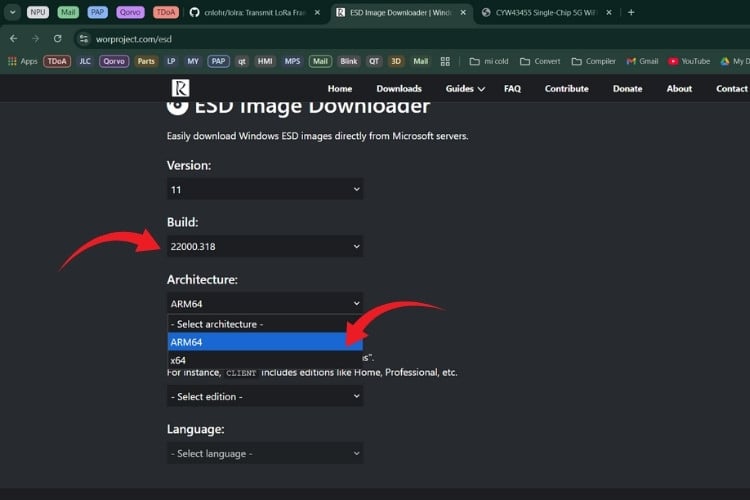
5. Next, pick the Edition you prefer. For example:
I went with Windows 11 Home (Client) ARM64 for testing.

6. Finally, choose your Language (I picked English (United States), but you can pick whichever suits you).
7. After making all these selections, click Download. The tool will fetch the official Windows files directly from Microsoft’s servers and create an ESD package for you.

8. Once downloaded, you can add the ESD file to the WoR Imager in the next step.
At the end of this process, I had a clean, ARM64-compatible Windows 11 image sitting on my PC, ready to flash onto the Raspberry Pi.
Once I had the Windows 11 ARM64 ESD image ready, the next challenge was to actually get it onto the Raspberry Pi. This is where the WoR Imager tool (Windows on Raspberry Pi Imager) comes in. Think of it as the bridge between the Windows image on your PC and your Raspberry Pi’s storage device.
Here’s exactly how I went through it:
Complete WoR Installation Process
1. First, I downloaded the Windows on Raspberry Pi Imager from the official WoR Project Downloads page.
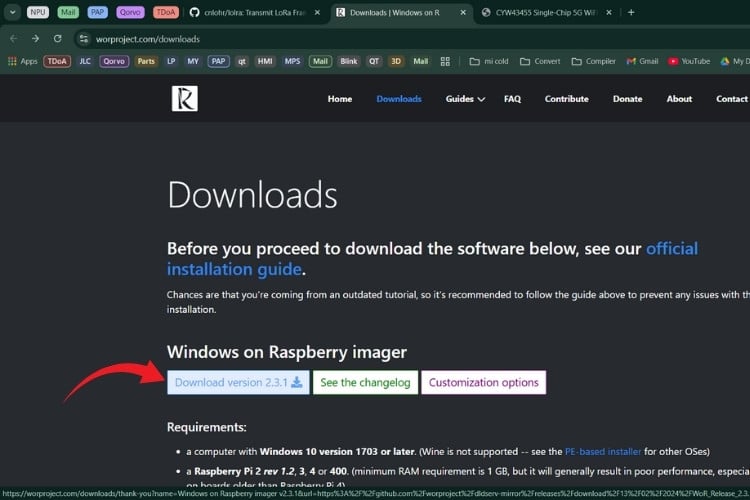
2. After extracting the ZIP file, I right-clicked on WoR.exe and selected Run as Administrator.
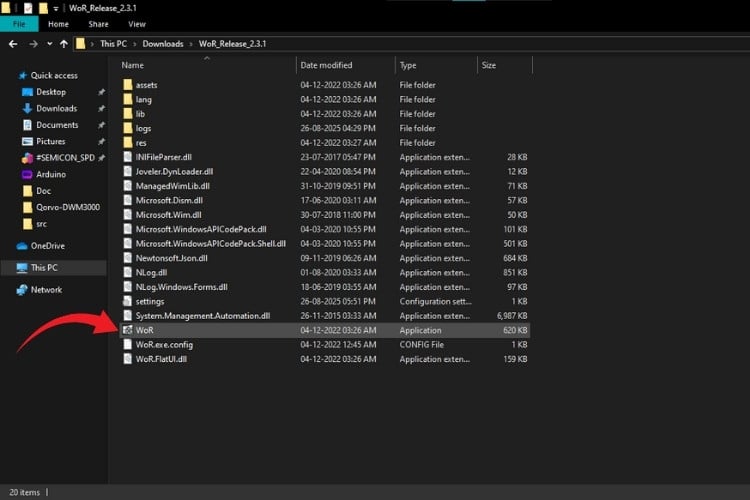
3. The Welcome screen of WoR Imager popped up. I clicked Next to begin.
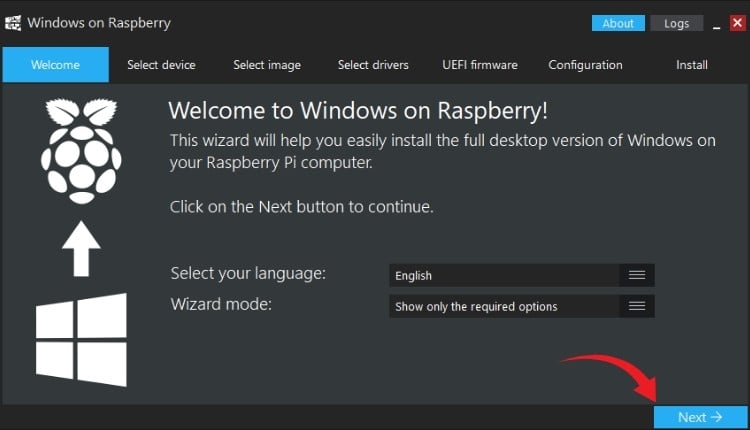
4. On the next screen, WoR asked me to select the storage device.
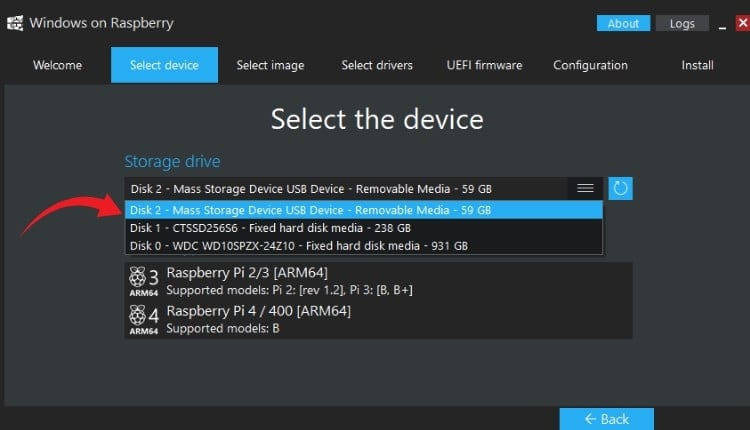
5. After picking the storage, I had to select the device type (Raspberry Pi model).
If you’re on Pi 4: Select Raspberry Pi 4/400.
If you’re on Pi 5: Here’s the trick: you actually need to choose the Raspberry Pi 2/3 option. Choosing Pi 4/400 results in an ACPI BIOS error when booting.
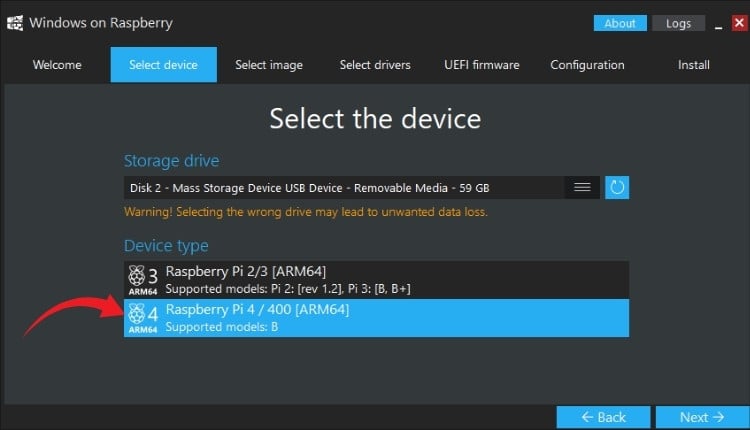
6. Next, WoR asked for the Image file. I clicked the (browse) button and pointed it to the Windows 11 ARM64 ESD/ISO I downloaded earlier.
7. The tool then let me pick which edition of Windows 11 I wanted to install (Home, Pro, etc.). I selected Windows 11 Pro ARM64 for additional features.
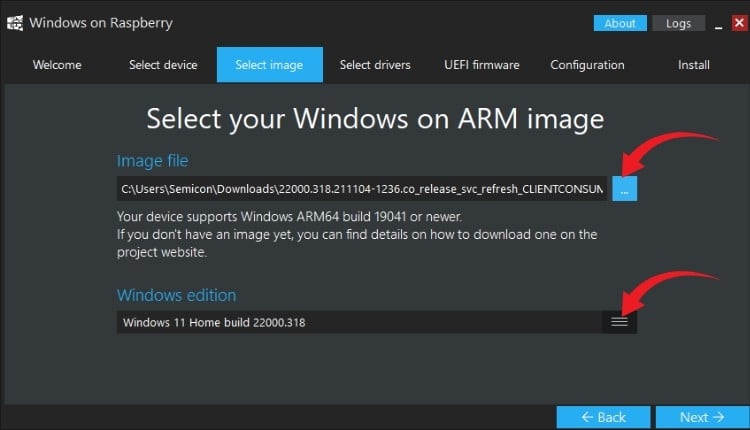
8. WoR then displayed an Installation Overview with my selections, device type, storage device, and image file location. After confirming, I clicked Install, and it prepared the storage device by partitioning, copying files, and setting up the UEFI bootloader.
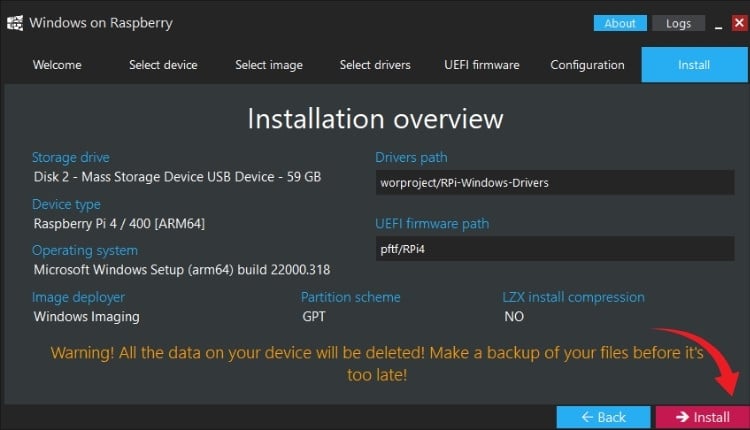
9. Depending on your PC and storage speed, this process can take anywhere from 15 to 45 minutes. I let it run, grabbed a coffee, and came back to see the success message.
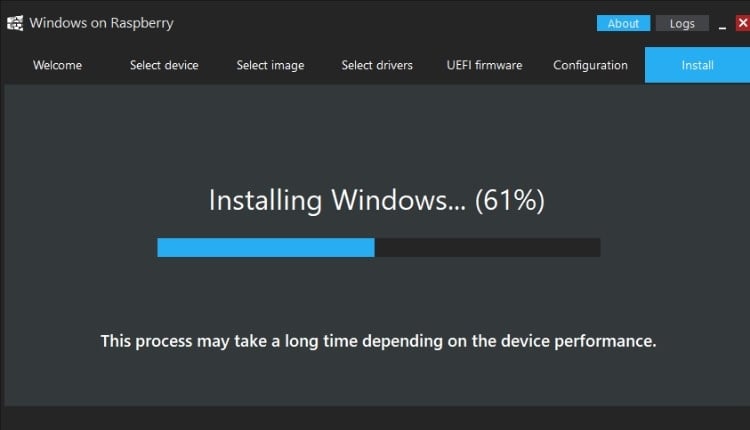
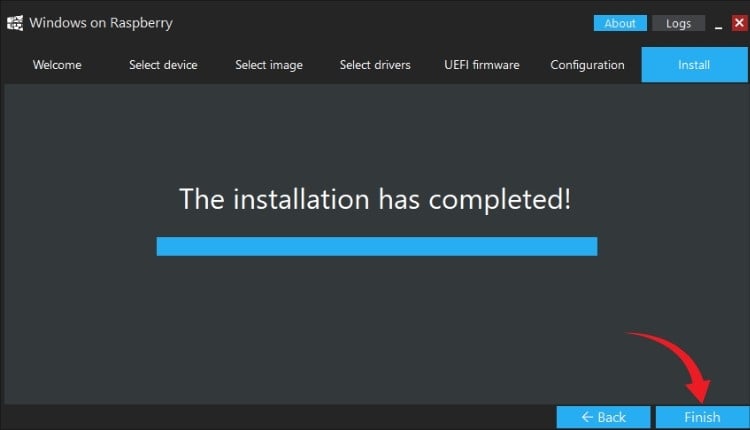
10. When it was finished, I hit Finish and safely ejected the storage device.
At this stage, my Raspberry Pi storage (microSD/SSD) had Windows 11 ARM fully installed on it. For Raspberry Pi 4 users, you can skip ahead to the boot section. But for Raspberry Pi 5 owners, there’s one extra step: setting up UEFI firmware (which I’ll cover in Step 3). Your Raspberry Pi storage now contains a complete Windows 11 ARM installation.
If you’re using a Raspberry Pi 4 or 3, you can skip this step completely. But when I moved to my Raspberry Pi 5, I quickly discovered that things weren’t as straightforward.
The issue is that the WoR installer doesn’t officially support the Pi 5 yet. If you try to boot Windows directly after flashing it with WoR, you’ll most likely be greeted with an ACPI BIOS error and a frozen boot screen. That’s where the UEFI firmware workaround comes in. When testing Windows 11 on Raspberry Pi 5, I encountered a significant obstacle: the WoR installer doesn't officially support Pi 5 yet.
Why Raspberry Pi 5 Needs UEFI Firmware
Here’s how I handled it:
The setup is more complex than Pi 4, but it's currently the only way to achieve Raspberry Pi 5 Windows 11 performance testing until WoR adds official Pi 5 support.
Technical Note: The microSD card must remain inserted permanently for Raspberry Pi 5 Windows 11 installations.
Before installing Windows 11 on a Raspberry Pi 4, there’s one extra step I highly recommend if you’re using a Raspberry Pi 4 or Raspberry Pi 3. Before installing Windows 11 on Raspberry Pi 4 or Pi 3, I strongly recommend updating the bootloader firmware. Updating the bootloader ensures that your Pi can boot cleanly from microSD cards or even from USB drives without weird glitches.
Bootloader Update Process
Here’s what I did:
1. On my Windows PC, I downloaded and launched the Raspberry Pi Imager and selected the board type.
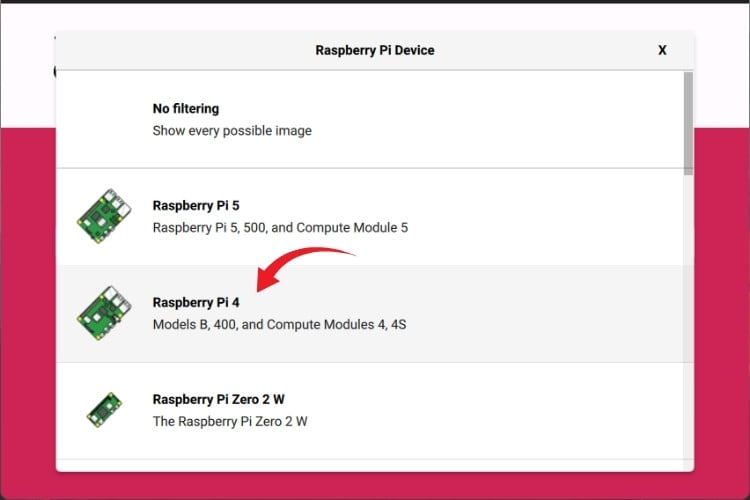
2. I clicked on Choose OS, then scrolled down to Misc utility images → Bootloader.
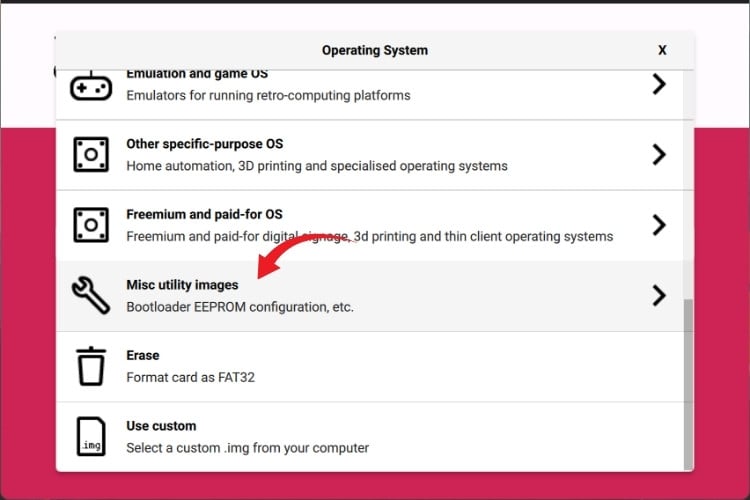
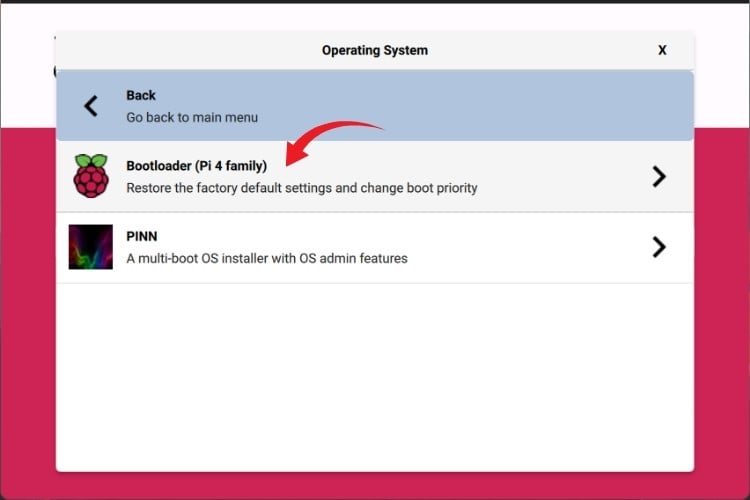
3. From there, I picked the boot mode I wanted:
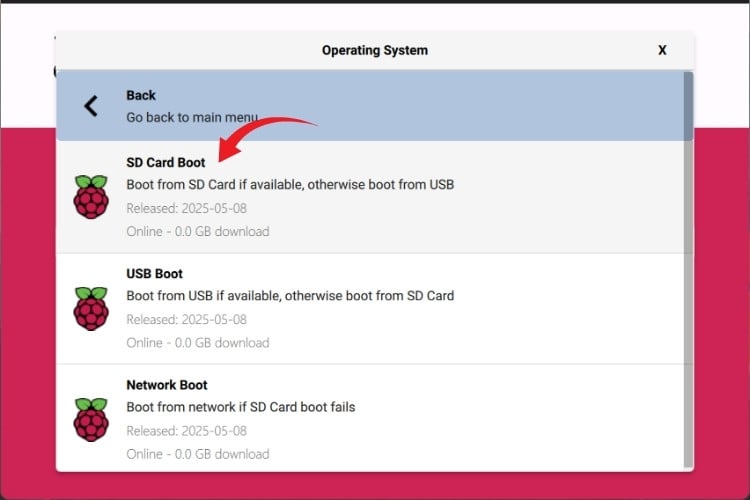
4. Then I clicked on Choose Storage and selected my microSD card (just a small one is fine, 1GB+ is enough).
5. Finally, I hit Write to flash the new bootloader to the card.
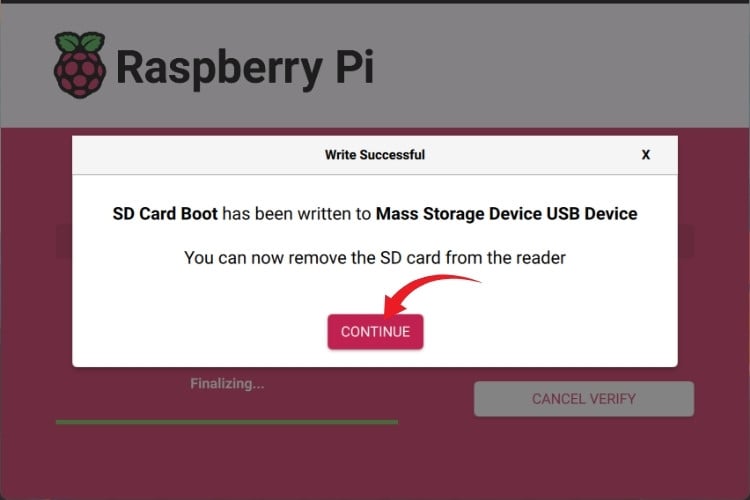
6. Once the process finished, I inserted the card into my Pi, plugged in the power, and waited.
First, the green ACT LED on the board blinked rapidly.
Then, the screen connected to my Pi turned solid green; this is the Pi’s way of telling you the bootloader update was successful.

7. After seeing the green screen, I shut down the Pi, removed the bootloader card, and set it aside. Now my Pi was running the latest boot firmware, ready for Windows 11. Your Raspberry Pi now runs the latest boot firmware optimised for Windows 11 on Raspberry Pi 4 installations.
This was the moment I had been waiting for: actually seeing Windows 11 come to life on my Raspberry Pi. After hours of downloading, flashing, and preparing firmware, it was finally time to plug everything in and hit the power button. This is the exciting moment of actually seeing Windows 11 ARM on Raspberry Pi boot for the first time.
Insert the storage devices
First boot screen: When I powered on the Pi, I saw the WoR/UEFI splash screen appear. On the Pi, it took a few extra seconds for the UEFI firmware to initialise, but eventually the Windows installer kicked in.
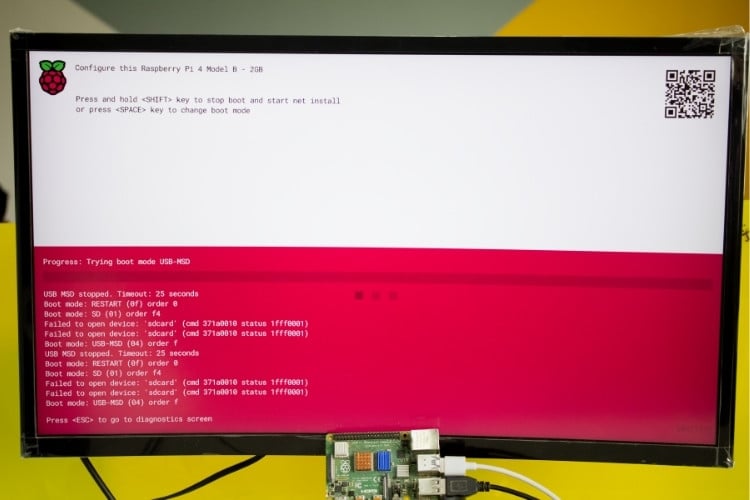
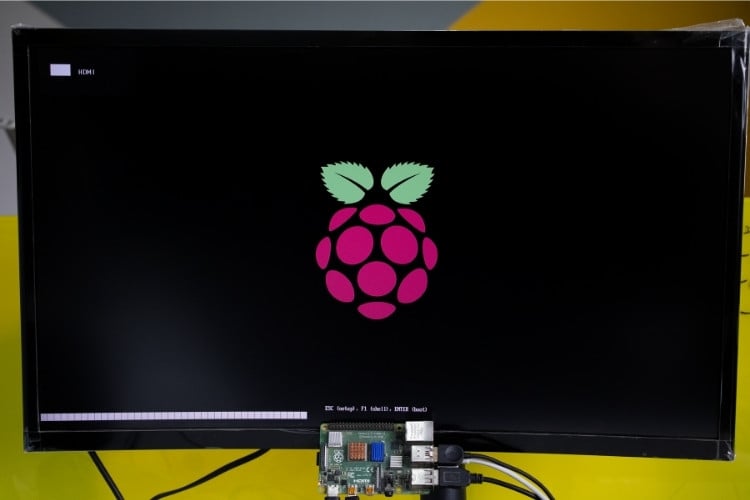
Region selection: The Windows installer asked me to choose my region. I picked India, but you can select your country/region from the list.
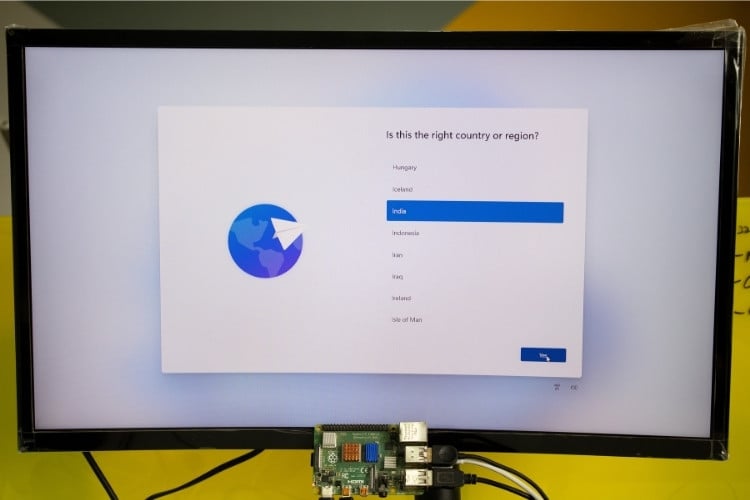
Keyboard layout: Next, it asked for a keyboard layout. I went with the US Keyboard, but you can add a layout if needed.
Network connection & Microsoft Account sign-in (…or not): Now, here’s where things got interesting. By default, Microsoft really wants you to sign in with a Microsoft account and stay connected to the internet during setup. They’ve been pushing this more and more in Windows 11, and on a Raspberry Pi, where networking is already a bit tricky, it feels like a roadblock designed just to test your patience. However, for Windows 11 Raspberry Pi installations where networking can be tricky, there's a workaround. Once you have network connectivity, you might want to configure a static IP address on your Raspberry Pi for stable remote access and development work. For comparison, see how Android performs on Raspberry Pi using emteria.OS—another alternative operating system experiment worth exploring.
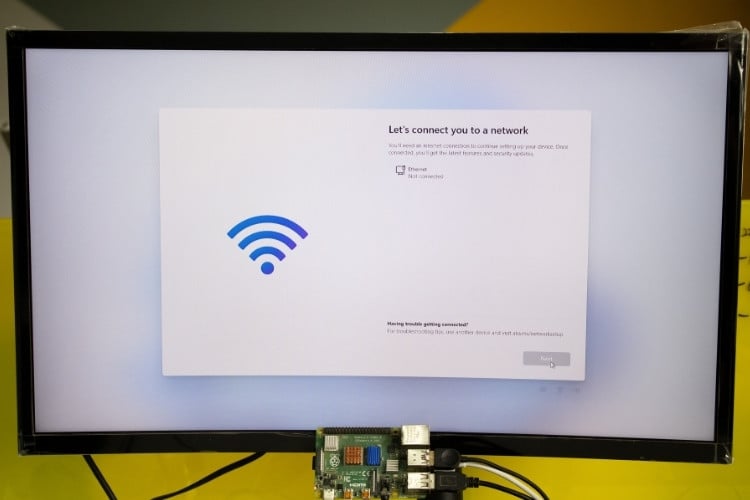
At first, I connected my phone for USB tethering and did it the “official” way, just like Microsoft intended. But then I thought: “Wait, this is a Raspberry Pi project… Do we really need to play by Microsoft’s rules?” Turns out, you don’t!
Here’s the fun workaround:
1. When you’re stuck at the “Let’s connect you to a network” screen, press Shift + F10 on your keyboard. This opens a secret Command Prompt window during the setup process. Yes, right in the middle of Windows Setup.
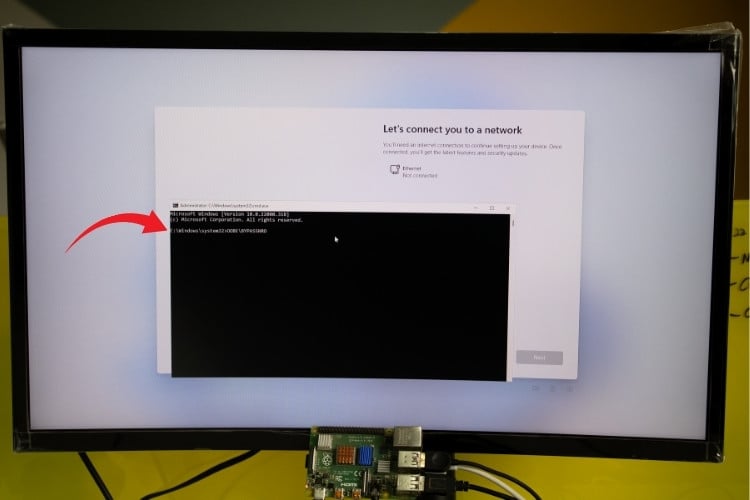
2. Type the following command and hit Enter:
| OOBE\BYPASSNRO |
3. The system will restart once, and when you’re back, voilà, there’s now an option to create a local account without needing any internet connection.

It’s almost like pulling the curtain back on Microsoft’s little magic trick. They try so hard to push you online, but one tiny command lets you skip the whole charade. Honestly, it felt like discovering a cheat code in a video game.
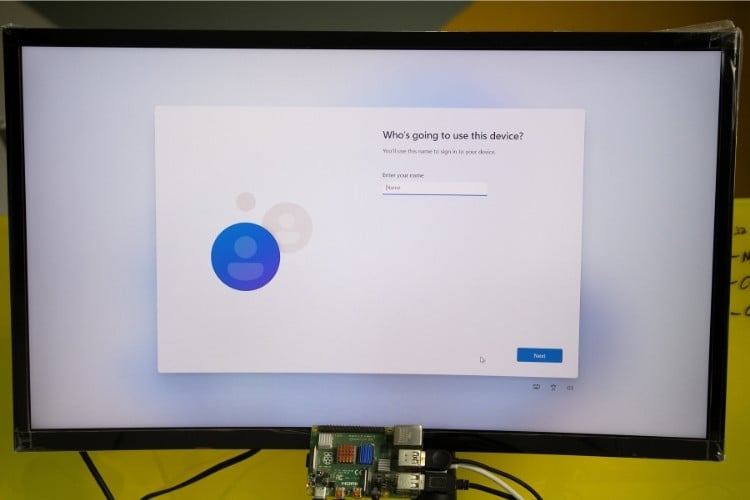
So whether you want to do it the “proper Microsoft way” (sign in with a Microsoft account and sync everything) or take the shortcut to a good old-fashioned local account, the choice is yours. I personally went with the bypass; it just felt more “Raspberry Pi hacker style.”
Privacy and personalisation options: The installer walked me through several toggles: location settings, data sharing, diagnostics, etc. I disabled most of them to save resources. Then it tried to upsell me on Microsoft 365 and Game Pass, and I skipped those, too. I disabled most options to conserve Raspberry Pi resources and improve Windows 11 on Raspberry Pi 4 performance.

First reboot: After completing all the setup steps, the Pi restarted once more. This time, instead of the installer, the Windows 11 desktop appeared in all its glory. The system even popped up a message saying it created a temporary paging file, which is normal on ARM devices.
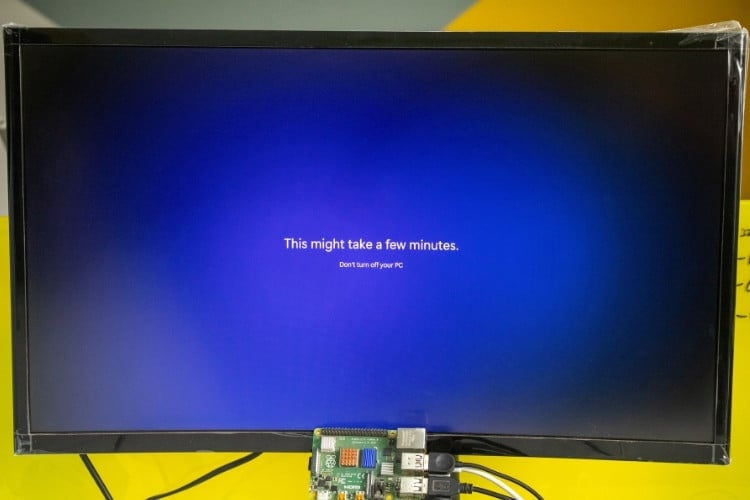
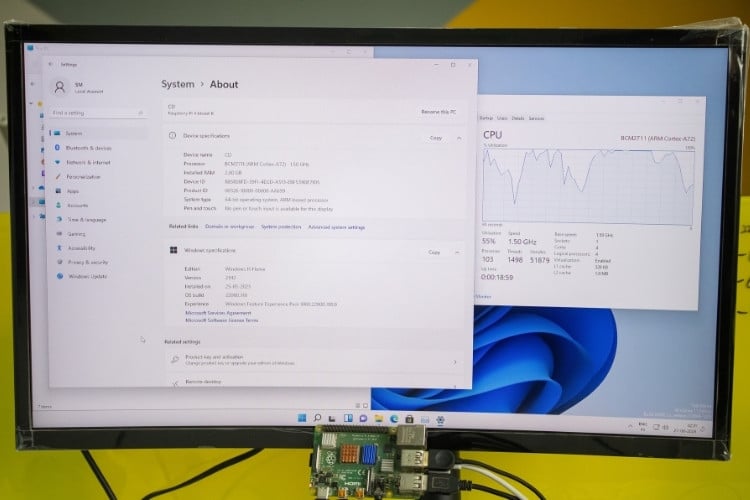
And there it was, Windows 11 running on a Raspberry Pi. Seeing the Start menu open on a tiny single-board computer honestly felt surreal. Sure, it wasn’t blazing fast, but it worked. I was able to launch Edge, browse the web, and even type this article draft from within Windows 11 on my Pi. While Raspberry Pi 5 Windows 11 performance isn't blazing fast, it's functional enough for web browsing, Office applications, and light development work.

While installing Windows 11 on Raspberry Pi is technically possible and educational, it's important to understand the significant limitations before committing time to this project.
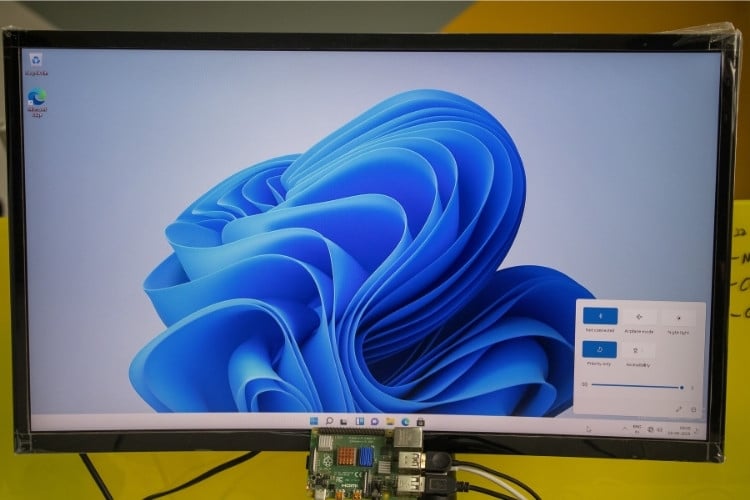
For projects requiring GPIO functionality, consider these alternatives: Controlling Raspberry Pi GPIO using MQTT Cloud or getting started with Raspberry Pi for full hardware access.
On the Raspberry Pi 4 (2GB), Windows felt more like a proof-of-concept. It worked, but you constantly hit memory limits, freezing, and slowdowns. Honestly, I wouldn’t recommend using 2GB unless you’re doing this just for fun. A 4GB or 8GB Pi 4 would perform better.
On the Raspberry Pi 5, the experience was dramatically better. Faster boot, smoother browsing, and fewer hangs. Still not “daily driver” level, but at least usable. With 4GB or 8GB RAM, Windows 11 on Raspberry Pi 4 becomes moderately usable.
After testing Windows 11 on Raspberry Pi 4 and Windows 11 on Raspberry Pi 5, the performance differences are substantial. Here's my real-world comparison based on extensive hands-on testing. Raspberry Pi 5 Windows 11 performance represents a significant leap forward. The Pi 5's improved CPU, faster memory, and better I/O make Windows 11 genuinely usable for everyday tasks.
| Metric | Raspberry Pi 4 (2GB) | Raspberry Pi 4 (4GB) | Raspberry Pi 5 (8GB) |
| Boot Time (Cold Start) | 5-6 minutes | 4-5 minutes | 1.5-2 minutes |
| Desktop Responsiveness | (Laggy) | (Moderate) | (Smooth) |
| Microsoft Edge Launch | 15-20 seconds | 10-12 seconds | 5-7 seconds |
| Web Browsing (3-5 tabs) | Frequent freezing | Usable, occasional lag | Generally smooth |
| Office Apps (Word/Excel) | Not recommended | Light documents only | Works well |
| Video Playback (720p) | Stuttering | Playable with drops | Smooth |
| Multitasking Capability | Very limited | 2-3 apps max | 5-6 apps comfortably |
| Overall Usability | Proof-of-concept only | Light tasks acceptable | Actually usable |
⇥ 1. Can I run Windows 11 on Raspberry Pi 3?
Yes, but it’s painfully slow. A Raspberry Pi 4 or 5 with at least 4GB RAM is highly recommended for usable performance.
⇥ 2. Do I really need to update the bootloader?
Not always, but if you’re on Pi 3 or Pi 4 and your board refuses to boot Windows, updating the bootloader with Raspberry Pi Imager usually fixes it.
⇥ 3. Why doesn’t WiFi work on Windows 11 for Raspberry Pi?
Because the WiFi chip manufacturer never released Windows ARM drivers. Without those, Windows simply can’t talk to the onboard WiFi hardware. Use a USB-Ethernet adapter or phone tethering instead.
⇥ 4. My Pi 5 shows an ACPI BIOS error when booting. What should I do?
That happens if you select the wrong device type in WoR. For Pi 5, always select Raspberry Pi 2/3 in WoR Imager and use the UEFI firmware microSD workaround.
⇥ 5. Can I create a local account instead of using a Microsoft account?
Yes! When stuck at the “Connect to network” screen, press Shift + F10, then type on CMD:
| OOBE\BYPASSNRO |
Hit Enter, and Windows will restart with the option to create a local account, no Microsoft account required.
⇥ 6. Why does my Pi take so long to boot Windows 11?
That’s normal. Windows 11 is heavy compared to Raspberry Pi OS. Expect around 4-5 minutes on Pi 4 and under 2 minutes on Pi 5.
⇥ 7. Can I use GPIO pins or other Pi hardware in Windows 11?
Not really. Windows doesn’t have drivers or APIs for Raspberry Pi GPIO. If GPIO access is critical, stick with Raspberry Pi OS or Linux.
⇥ 8. Which storage is best: microSD or SSD?
Windows 11 runs much faster from an SSD connected via USB 3. A microSD will work, but expect slower performance and longer boot times.
Running Windows 11 on Raspberry Pi 4 or 5 is like strapping a jet engine onto a bicycle. It works, but it’s clunky, quirky, and not officially supported. Still, it’s one of the most satisfying Pi experiments I’ve done. It’s not the smoothest ride, but if you’re a tinkerer like me, the process itself is worth it. The WoR team has made the impossible possible, and now you can show off Windows 11 running on a credit-card-sized board. To learn how to set up and configure your device, explore this comprehensive tutorial on installing Windows 10 IoT Core on Raspberry Pi.
I tested Windows 11 on Raspberry Pi 4 and Raspberry Pi 5 for a long period of time. Here are my humble thoughts: it's an interesting way to "experiment" and learn about things like ARM architecture, operating systems, and hardware restrictions; however, it's not intended to be a daily driver replacement for Raspberry Pi OS.
This tutorial was created by the Circuit Digest engineering team. Our experts focus on creating practical, hands-on tutorials that help makers and engineers master Raspberry Pi Projects, Arduino projects, and IoT development projects.
I hope you liked this article and learned something new from it. Share your Windows 11 Raspberry Pi journey in the comments below or use our Circuit Digest forum for a detailed discussion.
Would I use this daily? Probably not. But as a weekend project? Absolutely.
If you try this out, let me know how it went for you. I’d love to hear if you hit the same quirks or discovered new workarounds.
Explore essential Raspberry Pi tutorials covering setup, configuration, and performance enhancement for a wide range of DIY projects.
How to Boot Raspberry Pi from USB without SD Card
Learn how to boot a Raspberry Pi from USB without using an SD card. This step-by-step guide covers Raspberry Pi 3, 4, and 5 models, helping you improve system reliability and performance.
How to install Android on Raspberry Pi
In this tutorial, we will convert the Raspberry Pi into an Android device using a popular platform - emteria. OS.
How to Set a Static IP on Raspberry Pi?
Learn how to set a static IP on Raspberry Pi using NetworkManager (nmcli) and GUI methods. Complete step-by-step guide for Raspberry Pi OS Bookworm with screenshots and troubleshooting tips.
STMicroelectronics showcased what their STM32MP2 microprocessors are capable of at their electronica India 2025 booth. Visitors could play a game of tic-tac-toe with a robotic arm. The demonstration clearly exhibited how the chips allow for AI-powered robotic applications without cloud connectivity.
You’re hunting through component distributors trying to find that perfect microcontroller for your project. Let’s say you need three SPI controllers, I²C interfaces, and some specific ADC configuration. You go on to find something that has just the right number of SPI controllers, but before you celebrate, you notice it lacks I²C compatibility.
ROHM Semiconductor was among the key players that exhibited at electronica India 2025. The company’s Group Manager - Technical Centre, Balaji Karthic, while giving us an overview, called attention to their near two decades of research and development in SiC (silicon carbide) that led to their fifth-generation devices.

Your email is safe with us, we don’t spam.
Be a part of our ever growing community.